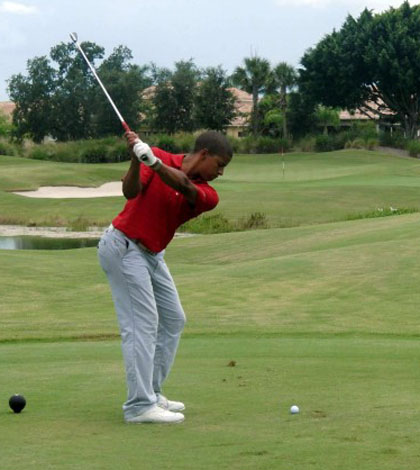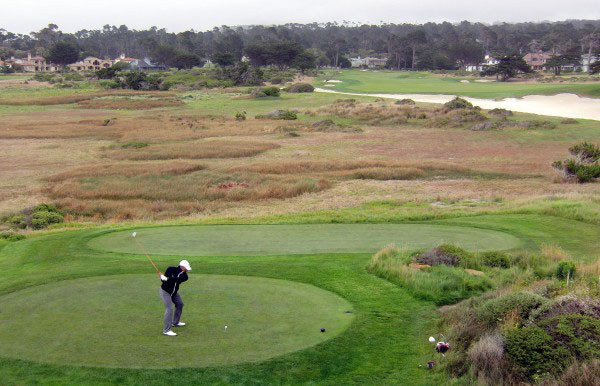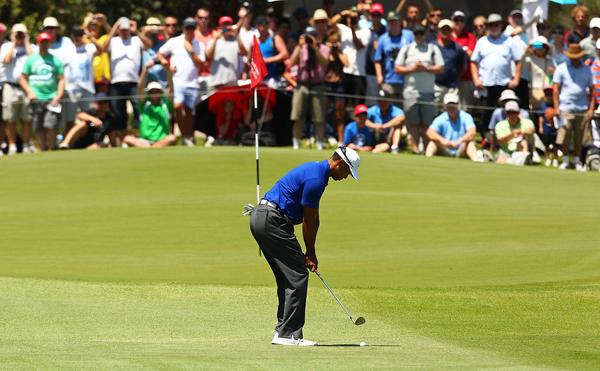Instruction
REAL Golf is different than RANGE golf

Golf is played on a golf course. Golf lessons are regularly taken on the driving range.
These are two quite obvious statements, I am sure you would agree. Yet the more I coach, the more I am convinced this needs to be addressed.
I work with many groups of golfers and often go to the course with them to see how they are playing. From my observation, and feedback from new and experienced golfers, players often cannot take their range game to the golf course. This may be due to nerves, bad feelings and more. Something has to change. The last time I checked, the only competitive measure of a golfer is how many contacts between club and ball are made starting from the tee on No. 1 and ending up on the green on No. 18.
I have seen a number of ideas, including:
- Simulating on the range what you want to do on the course, by creating virtual holes.
- Trying to recreate pressure situations on the range so you feel more accustomed to this on the course.
- Developing plenty of positive memories to look back on.
- Creating a consistent pre-shot routine that enables you to feel as comfortable and prepared on the first tee as you do on the driving range.
These are all positive ideas, but do they equal the full story? I believe these ideas create extra noise and things that the golfer should do, and attention gets taken off the actual task at hand. If these ideas were indeed the “magic pill” that golfers are always looking for, then the top golfers would never feel nervous on the first tee. After all, they have done this many times before, have played under the most extreme pressures and have many positive memories. The feelings of nervousness may be better controlled, but I struggle to believe Tiger or Rory are not slightly nervous or fired up as they go to tee No. 1 of a major.
Here are three of the common problems I encounter and some ideas to help get it right on the course:
No. 1. — Hitting from a mat aligned to one place
Unfortunately, as soon as golfers set foot onto the golf course, they come up against all the challenges that course designers put out there to make this game more difficult. Tee boxes are not always pointed straight down the fairway unlike the often square, non-movable shape of a driving range mat. This often leads to misalignment on the course, and as a result, completely different swings to those seen on the range. Now all of a sudden, the great swing you have been developing on the range will only ever lead to shots in the wrong direction, and a new, hybrid-swing full of compensations is the only way to make the golf ball go straight.
Solutions:
- When practicing, keep swapping targets so that you are not always just hitting shots aligned with the mat.
- On the course, aim at a closer, intermediate target, instead of using a skewed pointing tee-box as your marker and aiming far out into the distance.
2. Having a flat lie in practice
In the first three holes of the most recent round I played, my golfers found they had just three shots played from a flat bit of ground. All of these were tee shots. The rest were a combination of uphill, downhill and sidehill lies that needed small adjustments in technique, or some understanding of how the elements will likely affect the shot at hand. If the sum total of your golf practice is on the driving range, be careful; the majority of shots you hit out on the golf course will not be as straightforward as these. This doesn’t mean you need to spend endless hours perfecting each different lie, but just to develop some awareness to feel or see the differences in terrain and know the effect these will have.
Solutions:
- Take five golf balls and place them in different parts of the fairway with varying slopes. Think through what you want to try to do, or the effect the lie may have, before experimenting.
- Have a mix in your practice time. It is fine to strike golf balls on the driving range/practice ground, but flat ground is just one potential lie and you will also need to have encountered the other lies you will face on the course in your practice.
3. Learning a technique, not a skill
When out on the course, I have been pleased to see how well my players did around the greens and in the bunkers. The learning that we have done together has been focused on how the club and ball interacts to produce a shot (see my previous GolfWRX post about it here) and as a result they had confidence in facing new situations on the course. Instead of learning how to play one shot, these golfers learned how to control the golf ball in different ways. Learning through guided experimentation what makes a chip shot go low/high, or land soft/roll a lot after landing, gives you the chance to build an adaptable skill-set and not be phased by situations on the course. If you just learn techniques of how to play a “chip shot” you become more rigid and different shots on the course appear a big challenge.
Solutions:
- Throw 20 golf balls down around a practice green and then try to hit them all close to the hole. You will have to use a variety of high and low shots, probably with different clubs. Experimentation will lead to increased awareness and development of your skill-set and creativity, instead of learning of just one specific technique.
The best solution? Why not take a playing lesson with your local professional. Get them to play alongside you and:
- Be your caddy and help with decision making for your shots.
- Play with you and talk you through all of the things they are considering before playing a shot.
I guarantee these ideas will help you transfer your range game to the course.
- LIKE11
- LEGIT1
- WOW0
- LOL1
- IDHT0
- FLOP3
- OB1
- SHANK2
Instruction
The Wedge Guy: The easiest-to-learn golf basic

My golf learning began with this simple fact – if you don’t have a fundamentally sound hold on the golf club, it is practically impossible for your body to execute a fundamentally sound golf swing. I’m still a big believer that the golf swing is much easier to execute if you begin with the proper hold on the club.
As you might imagine, I come into contact with hundreds of golfers of all skill levels. And it is very rare to see a good player with a bad hold on the golf club. There are some exceptions, for sure, but they are very few and very far between, and they typically have beat so many balls with their poor grip that they’ve found a way to work around it.
The reality of biophysics is that the body moves only in certain ways – and the particulars of the way you hold the golf club can totally prevent a sound swing motion that allows the club to release properly through the impact zone. The wonderful thing is that anyone can learn how to put a fundamentally sound hold on the golf club, and you can practice it anywhere your hands are not otherwise engaged, like watching TV or just sitting and relaxing.
Whether you prefer an overlap, interlock or full-finger (not baseball!) grip on the club, the same fundamentals apply. Here are the major grip faults I see most often, in the order of the frequency:
Mis-aligned hands
By this I mean that the palms of the two hands are not parallel to each other. Too many golfers have a weak left hand and strong right, or vice versa. The easiest way to learn how to hold the club with your palms aligned properly is to grip a plain wooden ruler or yardstick. It forces the hands to align properly and shows you how that feels. If you grip and re-grip a yardstick several times, then grip a club, you’ll see that the learning curve is almost immediate.
The position of the grip in the upper/left hand
I also observe many golfers who have the butt of the grip too far into the heel pad of the upper hand (the left hand for right-handed players). It’s amazing how much easier it is to release the club through the ball if even 1/4-1/2″ of the butt is beyond the left heel pad. Try this yourself to see what I mean. Swing the club freely with just your left hand and notice the difference in its release from when you hold it at the end of the grip, versus gripping down even a half inch.
To help you really understand how this works, go to the range and hit shots with your five-iron gripped down a full inch to make the club the same length as your seven-iron. You will probably see an amazing shot shape difference, and likely not see as much distance loss as you would expect.
Too much lower (right) hand on the club
It seems like almost all golfers of 8-10 handicap or higher have the club too far into the palm of the lower hand, because that feels “good” if you are trying to control the path of the clubhead to the ball. But the golf swing is not an effort to hit at the ball – it is a swing of the club. The proper hold on the club has the grip underneath the pad at the base of the fingers. This will likely feel “weak” to you — like you cannot control the club like that. EXACTLY. You should not be trying to control the club with your lower/master hand.
Gripping too tightly
Nearly all golfers hold the club too tightly, which tenses up the forearms and prevents a proper release of the club through impact. In order for the club to move back and through properly, you must feel that the club is controlled by the last three fingers of the upper hand, and the middle two fingers of the lower hand. If you engage your thumbs and forefingers in “holding” the club, the result will almost always be a grip that is too tight. Try this for yourself. Hold the club in your upper hand only, and squeeze firmly with just the last three fingers, with the forefinger and thumb off the club entirely. You have good control, but your forearms are not tense. Then begin to squeeze down with your thumb and forefinger and observe the tensing of the entire forearm. This is the way we are made, so the key to preventing tenseness in the arms is to hold the club very lightly with the “pinchers” — the thumbs and forefingers.
So, those are what I believe are the four fundamentals of a good grip. Anyone can learn them in their home or office very quickly. There is no easier way to improve your ball striking consistency and add distance than giving more attention to the way you hold the golf club.
More from the Wedge Guy
- The Wedge Guy: Golf mastery begins with your wedge game
- The Wedge Guy: Why golf is 20 times harder than brain surgery
- The Wedge Guy: Musings on the golf ball rollback
- LIKE86
- LEGIT13
- WOW6
- LOL1
- IDHT0
- FLOP4
- OB1
- SHANK8
Instruction
Clement: Stop ripping off your swing with this drill!

Not the dreaded headcover under the armpit drill! As if your body is defective and can’t function by itself! Have you seen how incredible the human machine is with all the incredible feats of agility all kinds of athletes are accomplishing? You think your body is so defective (the good Lord is laughing his head off at you) that it needs a headcover tucked under the armpit so you can swing like T-Rex?
- LIKE0
- LEGIT2
- WOW2
- LOL0
- IDHT0
- FLOP0
- OB0
- SHANK2
Instruction
How a towel can fix your golf swing

This is a classic drill that has been used for decades. However, the world of marketed training aids has grown so much during that time that this simple practice has been virtually forgotten. Because why teach people how to play golf using everyday items when you can create and sell a product that reinforces the same thing? Nevertheless, I am here to give you helpful advice without running to the nearest Edwin Watts or adding something to your Amazon cart.
For the “scoring clubs,” having a solid connection between the arms and body during the swing, especially through impact, is paramount to creating long-lasting consistency. And keeping that connection throughout the swing helps rotate the shoulders more to generate more power to help you hit it farther. So, how does this drill work, and what will your game benefit from it? Well, let’s get into it.
Setup
You can use this for basic chip shots up to complete swings. I use this with every club in my bag, up to a 9 or 8-iron. It’s natural to create incrementally more separation between the arms and body as you progress up the set. So doing this with a high iron or a wood is not recommended.
While you set up to hit a ball, simply tuck the towel underneath both armpits. The length of the towel will determine how tight it will be across your chest but don’t make it so loose that it gets in the way of your vision. After both sides are tucked, make some focused swings, keeping both arms firmly connected to the body during the backswing and follow through. (Note: It’s normal to lose connection on your lead arm during your finishing pose.) When you’re ready, put a ball in the way of those swings and get to work.

Get a Better Shoulder Turn
Many of us struggle to have proper shoulder rotation in our golf swing, especially during long layoffs. Making a swing that is all arms and no shoulders is a surefire way to have less control with wedges and less distance with full swings. Notice how I can get in a similar-looking position in both 60° wedge photos. However, one is weak and uncontrollable, while the other is strong and connected. One allows me to use my larger muscles to create my swing, and one doesn’t. The follow-through is another critical point where having a good connection, as well as solid shoulder rotation, is a must. This drill is great for those who tend to have a “chicken wing” form in their lead arm, which happens when it becomes separated from the body through impact.
In full swings, getting your shoulders to rotate in your golf swing is a great way to reinforce proper weight distribution. If your swing is all arms, it’s much harder to get your weight to naturally shift to the inside part of your trail foot in the backswing. Sure, you could make the mistake of “sliding” to get weight on your back foot, but that doesn’t fix the issue. You must turn into your trial leg to generate power. Additionally, look at the difference in separation between my hands and my head in the 8-iron examples. The green picture has more separation and has my hands lower. This will help me lessen my angle of attack and make it easier to hit the inside part of the golf ball, rather than the over-the-top move that the other picture produces.


Stay Better Connected in the Backswing
When you don’t keep everything in your upper body working as one, getting to a good spot at the top of your swing is very hard to do. It would take impeccable timing along with great hand-eye coordination to hit quality shots with any sort of regularity if the arms are working separately from the body.
Notice in the red pictures of both my 60-degree wedge and 8-iron how high my hands are and the fact you can clearly see my shoulder through the gap in my arms. That has happened because the right arm, just above my elbow, has become totally disconnected from my body. That separation causes me to lift my hands as well as lose some of the extension in my left arm. This has been corrected in the green pictures by using this drill to reinforce that connection. It will also make you focus on keeping the lead arm close to your body as well. Because the moment either one loses that relationship, the towel falls.


Conclusion
I have been diligent this year in finding a few drills that target some of the issues that plague my golf game; either by simply forgetting fundamental things or by coming to terms with the faults that have bitten me my whole career. I have found that having a few drills to fall back on to reinforce certain feelings helps me find my game a little easier, and the “towel drill” is most definitely one of them.
- LIKE12
- LEGIT2
- WOW2
- LOL0
- IDHT0
- FLOP2
- OB0
- SHANK8
-

 19th Hole2 weeks ago
19th Hole2 weeks agoDave Portnoy places monstrous outright bet for the 2024 Masters
-

 19th Hole2 weeks ago
19th Hole2 weeks agoTiger Woods arrives at 2024 Masters equipped with a putter that may surprise you
-

 19th Hole3 weeks ago
19th Hole3 weeks agoReport: Tiger Woods has ‘eliminated sex’ in preparation for the 2024 Masters
-

 19th Hole1 week ago
19th Hole1 week agoTwo star names reportedly blanked Jon Rahm all week at the Masters
-

 19th Hole6 days ago
19th Hole6 days agoReport: LIV Golf identifies latest star name they hope to sign to breakaway tour
-

 19th Hole1 week ago
19th Hole1 week agoNeal Shipley presser ends in awkward fashion after reporter claims Tiger handed him note on 8th fairway
-

 19th Hole3 hours ago
19th Hole3 hours ago‘Absolutely crazy’ – Major champ lays into Patrick Cantlay over his decision on final hole of RBC Heritage
-

 19th Hole5 days ago
19th Hole5 days agoBrandel Chamblee has ‘no doubt’ who started the McIlroy/LIV rumor and why


















Lowell
Apr 30, 2015 at 7:50 pm
I am complete agreement that one must practice the course to get better at developing their game. I have incorporated more course practice and for me it is paying dividends on both approach shots as well as around the green from 100 yards in. I recommend to anyone to go out to your course when the course has died down a bit a take 1 to 3 shots off the tee and proceed to do that all the way into the green. I would often drop a golf ball on certain yardages to see different ways to play them. Whether high soft shots into a green or a bump and run with a longer club. Once I am around the green, I play 3 to 5 golf balls where I again see what kind of release or ball action I get playing my wedges open and closed. Its amazing how many ways you can play a shot into a green. Only then can you build a sort of history to fall back on when playing other rounds. Practicing on the range especially on the chipping greens trains your mind to remember it just as you practiced it. If you take that mind frame to the golf course, you do not quite remember it the same way since you remember a chipping green with multiple little flags. When you practice on the course, the chips and pitches you practice actually do train you to play it as you see it and develop mental memory. Soon enough, those chips or pitches you stand over with question marks, will be more routine feeling and not as stressful. Work on swing mechanics on the range but practice on the course. Work on chipping technique on the chipping green but practice short game on the golf course. Trust me, it will pay dividends on your score and your overall game.
Jack
Sep 11, 2013 at 5:09 am
Of course it’s easier on the range. You don’t have to putt out the 50 foot misses with your 7 iron. When you slice your driver who cares where it lands. Even if you hit your driver straight, it would still never land in the rough or a divot or a bunker. You just go and hit the next shot.
Chazzell
Sep 7, 2013 at 7:25 pm
I am a scratch handicap on the range and a 15 on the course. Sooooo frustrating. There has to be a way to bring it to the course.
Jtriscott
Aug 2, 2013 at 4:27 pm
“Play with you and talk you through all of the things they are considering before playing a shot.”
Sounds like a 5 hour round coming…
James
Jun 18, 2013 at 9:28 am
Totally agree, its so easy to blast balls down the range, but its much harder when you actually have something to aim at!
I try to mix it up with 30 mins range time to get warmed up, followed by 9 holes course time…i definitely prefer being out on the course though
Daniel Grumberg
May 20, 2013 at 4:55 pm
Excellent article. My extra advice to anybody that plays decent golf : go out on the course for a quick nine instead of spending 1h30 on the range. Playing golf and hitting golf balls isn’t the same thing and being on course is also much more fun !
Pablo Heitmeyer
Mar 21, 2013 at 3:52 am
Limited distance range balls and / or seriously worn out/deformed range balls make ‘practicing’ on the golf course difficult sometimes when you are trying to groove a distance.
mlamb
Mar 20, 2013 at 11:13 am
Good article.
In my view, the biggest issue with the driving range is the use of a mat. Zero feedback with irons. Limited distance range balls don’t help either.
Pingback: REAL Golf is different than RANGE golf – GolfWRX | My Golf Drill